Zone 2 Heart Rate Training: Boost Endurance, Burn Fat, and Improve Performance
I am just tired of being tired. In my case, it is on the pickup basketball court. It seems like after 2 possessions I am already gassed. I know I am not going to be 18 again or even what I was 10 years ago, but it is frustrating. I hear Peter Attia, MD, Rich Roll, and other health and fitness podcasters talk about the importance of Zone 2 training as a key component to increased cardiovascular fitness. I like the base idea of getting, as Attia calls it, the base of your pyramid very wide and stable with zone 2 and then getting the top very high with higher intensity zone 5 training (I am already doing a tiger sprinting workout).
“By training zone 2 and zone 5 . . . we’re really teeing ourselves up metabolically and also structurally to do these things.”
Dr. Peter Attia
I just had to more fully understand what encompasses zone 2 training. Can I reach that level on my under-desk treadmill?
If so, it should be easy enough. Well, guess what, even though this is a lower-intensity workout than running or HIIT finding that sweet spot of zone 2 is a little more difficult to manage than I would have thought. Spoiler alert: I can’t get into Zone 2 with my Sunny Underdesk Treadmill that tops out at 3.75 mph ( I normally use it at 2.6 to 3.1 mph, any higher and I risk falling off).
This post is much of my research and personal experience trying to find ways to do the training in an efficient manner over the last 2 to 3 months. Here are the 3 major things I will cover:
- Understanding the different heart rate zones.
- Benefits I hope to get from the training.
- Examples of my workouts that have yielded the moze zone 2 time and how I plan to better incorporate it into my weekly routine.
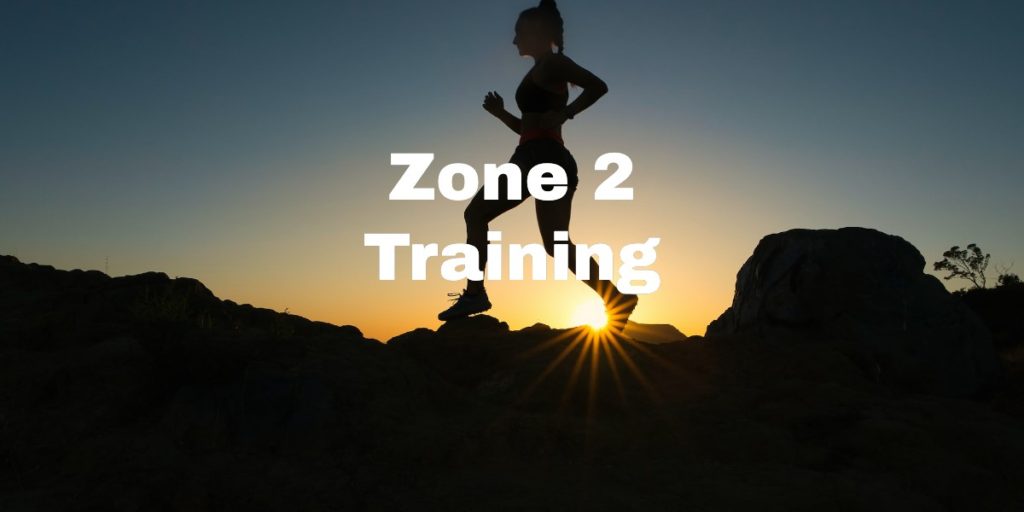
Understanding Heart Rate Zones
Before we jump into the specifics of Zone 2 Training, let’s take a moment to understand heart rate zones. These are simply different intensity levels of exercise, based on your maximum heart rate (MHR). There are five heart rate zones you should be familiar with:
- Zone 1: Recovery – Light exercise for active recovery.
- Zone 2: Aerobic Endurance – The focus of this post, and where the magic happens.
- Zone 3: Tempo – Slightly more intense, but still aerobic.
- Zone 4: Threshold – High intensity, where you start to feel the burn.
- Zone 5: VO2 Max – The limit of your body’s ability to use oxygen.
To determine your heart rate zones, you can use the age-based formula (220 – your age = MHR), lactate threshold testing, or field tests. Check out this article for more details on each method.
Everyone is going to be be different based on their current fitness level. I just happened to start using a Whoop band which allows you to track your workout and works out how much of it you spend in zones 1 through 5. I can’t speak to if it is perfectly accurate, but it at least has given me an easy way to monitor it. I have tracked myself during pick up basketball games, more casual walks with my wife, on my underdeske treadmill, and more recently, more intense and purposeful walks outside trying to maintain zone 2 levels. The image below is from Whoop band on one of my typical 20 minute walks back and forth to the quickie mart to get my Diet Coke. I usually get 9 to 10 minutes credit if I walk with purpose.
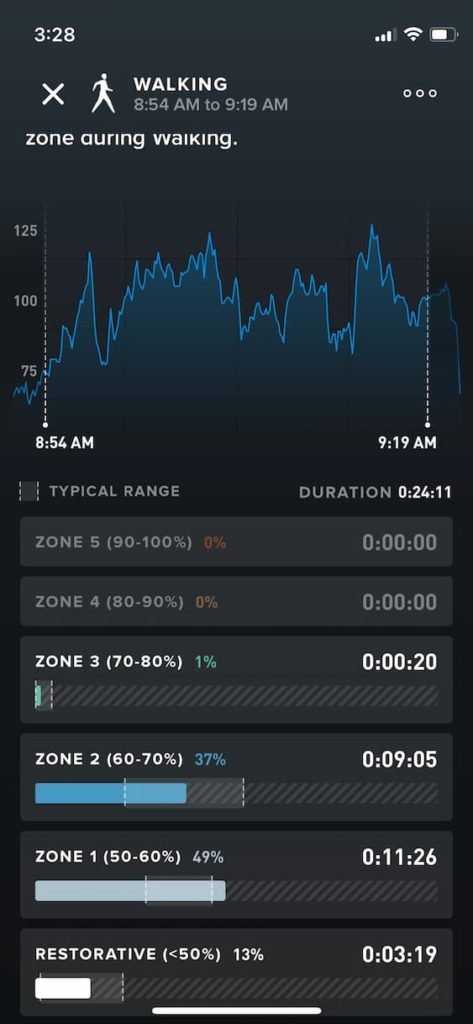
Benefits of Zone 2 Training
Now that we’ve established what Zone 2 Training is, let’s dive into its numerous benefits:
- Enhanced aerobic endurance: Training in Zone 2 strengthens your heart, lungs, and muscles, allowing you to go longer and harder during workouts.
- Increased fat burning: Zone 2 is the sweet spot for fat burning, as your body uses more fat for energy at this intensity.
- Improved cardiovascular health: Lower-intensity exercise, like Zone 2 Training, helps reduce blood pressure and cholesterol levels.
- Faster recovery times: Working out in Zone 2 doesn’t put as much strain on your body, allowing for quicker recovery.
- Reduced risk of injury: Lower-intensity workouts mean less wear and tear on your body.
- Mental benefits: Zone 2 Training can help reduce stress and anxiety, thanks to the release of endorphins.
- Greater workout efficiency: Building a strong aerobic base through Zone 2 Training makes your other workouts more effective.
How to Incorporate Zone 2 Training into Your Routine
Starting with Zone 2 Training
First, assess your current fitness level. If you’re new to exercise or coming back from a break, take it slow. Begin with shorter sessions (20-30 minutes) and gradually increase the duration as you get more comfortable.
Establish a workout schedule that includes both Zone 2 and higher-intensity sessions. For example, you could alternate days between Zone 2 Training and more intense workouts, or dedicate specific days to each.
Activities for Zone 2 Training
There’s no shortage of activities you can do in Zone 2. Some popular options include:
- Running
- Cycling
- Swimming
- Rowing
- Hiking
- Group fitness classes (e.g., yoga, Pilates, or spin)
Choose an activity that you enjoy and can stick with long-term. This table shows how much time was spent in zone 2 in actual workouts I have done to give you some examples of what to expect from various exercise activities. You can see that intense purposeful walks have been th most effecient for me. I live in a hilly neighborhood and can maintain zone 2 while going up hill, but I have to pepper in a little light jogging on the downhill portions to keep my
| Zone 2 Activity | Time In Zone 2 | Total Time |
| Intense\Purposeful Outdoor Walking | 21:13 | 00:24:29 |
| Pick Up Basketball | 14:31 | 1:22:42 |
| Doug McGuff Weights Workout | 20:25 | 00:00:21 |
| Casual Walk | 9:05 | 00:24:11 |
The following are screen shots from my Whoop band for the various workouts so you can see visually when I am in and out of zone 2. Right now, my zone 2 range is around 106 to 124 beats per minute.
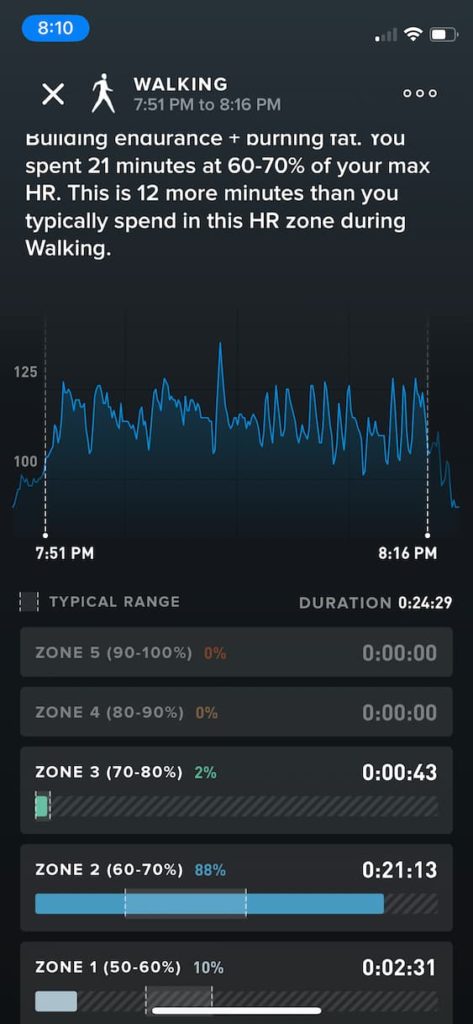
Zone 2 Intense\Purposeful Outdoor Walking
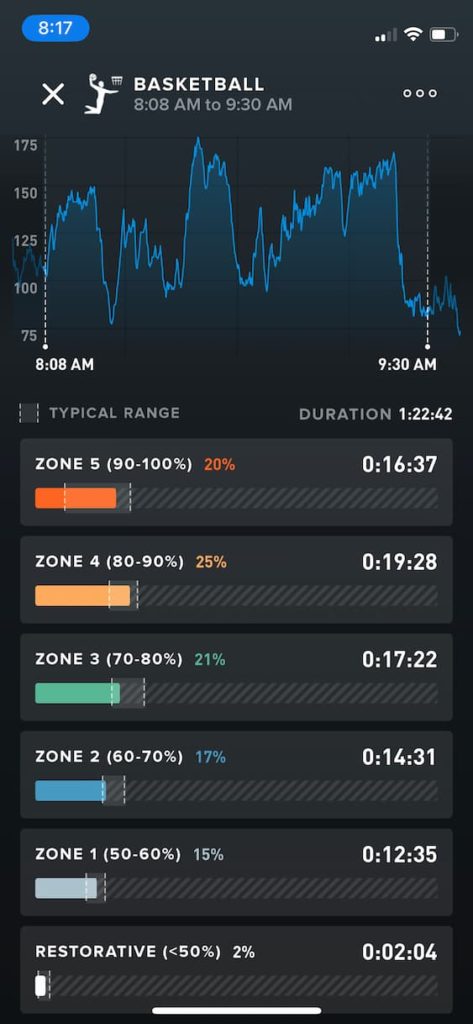
Zone 2 While Playing Pick-Up Basketball

Zone 2 Short Casual Walk
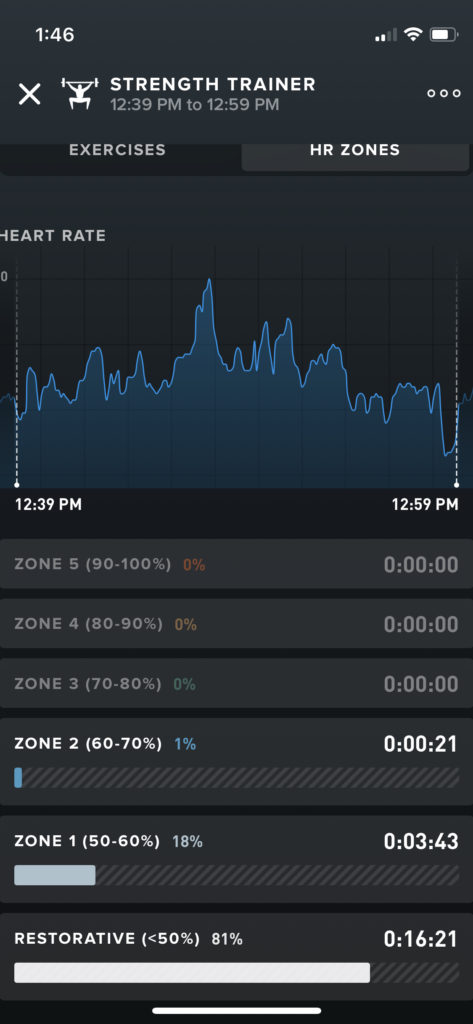
Doug McGuff Zone 2 Weights Workout
Monitoring your heart rate
To ensure you’re training in the correct zone, it’s essential to monitor your heart rate. There are several ways to do this:
- Heart rate monitors: Chest strap monitors provide the most accurate readings.
- Smartwatches and fitness trackers: Wearable devices like these offer heart rate monitoring and additional features. I have Whoop band and an Oura ring.
- Perceived exertion: If you don’t have access to a device, use the Borg Scale to gauge your intensity level.
Progressing with Zone 2 Training
As you adapt to Zone 2 Training, consider these strategies to continue progressing:
- Increasing duration: Gradually add more time to your Zone 2 sessions.
- Adjusting workout intensity: Mix in higher-intensity workouts for a well-rounded routine.
- Balancing Zone 2 and high-intensity workouts: Ensure you’re giving your body enough recovery time between sessions.
Attia’s website indicates beginners should try to do 2 hours of zone 2 a week and try and move up to 3 to 4 hours a week. In a perfect world I would like to do 4 dedicated 45 minutes sessions. Assuming I could keep 80% of it in zone 2 that would get me to around 144 minutes. But to find time for those longer dedicates sessions is difficult. Right now most of mine are 20 – 25 minutes at a time. My hope is to find some way to incorporate a session or two a week while I am working. If you find a portable foldable desk attachment for a treadmill let me know. I would take it into my co working space gym.
Common Mistakes and Misconceptions
Avoid these common pitfalls when implementing Zone 2 Training:
- Overestimating heart rate: Don’t rely solely on perceived exertion. Use a heart rate monitor or fitness tracker to stay in the correct zone.
- Neglecting other training zones: A balanced fitness routine includes a mix of intensity levels.
- Expecting immediate results: Zone 2 Training is a long-term investment in your fitness. Be patient, and the results will come.
One problem I had was that when I realized I couldn’t get to zone 2 on my underdesk treadmill I stopped using it as often. Thinking it was a waste to not use the time to get to zone 2. Guess what, I just ended up moving less overall and have gone plus about 7 pounds. Not a great strategy. Some movement is better than nothing.
Conclusion
Zone 2 Training offers numerous benefits, from increased endurance and fat burning to improved cardiovascular health and reduced risk of injury. By incorporating this training method into your routine, you’re making a long-term investment in your fitness and well-being.
Now, it’s your turn. Give Zone 2 Training a try and track your progress. Share your experiences and successes with others, and let’s unlock the power of Zone 2 Training together.
What exactly is Zone 2 Training?
Zone 2 Training is a form of aerobic exercise performed at a moderate intensity level, targeting the heart rate zone where your body primarily burns fat for energy and improves cardiovascular endurance.
How can I determine my Zone 2 heart rate range?
You can determine your Zone 2 heart rate range by using the age-based formula (220 – your age = MHR), lactate threshold testing, or field tests. Each method helps calculate your heart rate zones, with Zone 2 typically falling between 60% and 70% of your maximum heart rate.
What are the primary benefits of Zone 2 Training?
The primary benefits of Zone 2 Training include enhanced aerobic endurance, increased fat burning, improved cardiovascular health, faster recovery times, reduced risk of injury, mental benefits, and greater workout efficiency.
Which activities can I perform for Zone 2 Training?
Popular activities for Zone 2 Training include running, cycling, swimming, rowing, hiking, and group fitness classes like yoga, Pilates, or spin. Choose an activity that you enjoy and can stick with long-term.
How often should I incorporate Zone 2 Training into my workout routine?
A balanced workout routine should include both Zone 2 and higher-intensity sessions. You can alternate days between Zone 2 Training and more intense workouts or dedicate specific days to each. The key is to ensure you’re giving your body enough recovery time between sessions.
Troy Wallace
Troy Wallace is Certified Basketball Speed Specialist and shares his experiences in trying to stay as healthy as possible to stay on the court. He is active in coaching youth basketball in YMCA, Team Work Sports Nebraska, and, currently, in the Jr. Warriors program in Omaha, NE. Visit Troy's Full Author Bio Page or email him directly.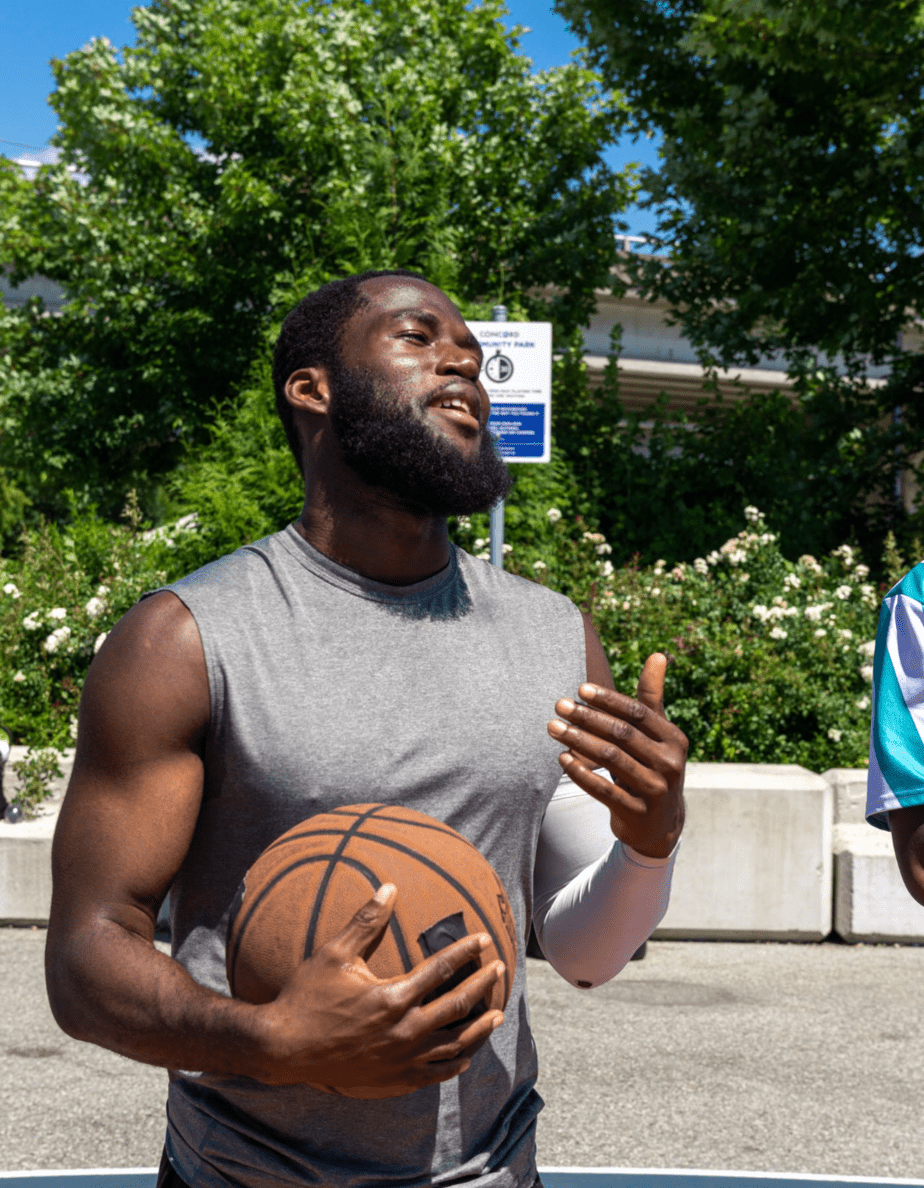
Meaningful conversations happening daily about training, recovery, and injury-specific rehabilitation as well as sport-specific discussions on playing, coaching and refereeing your favorite sport. We welcome experts and those with curious minds seeking answers.
Join The Stay On The Court Community!